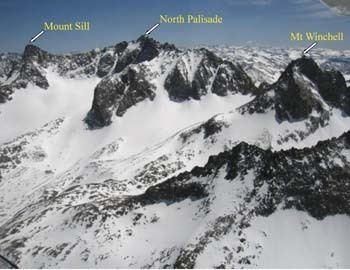Isolation 32.2 mi (51.8 km) Prominence 882 m | Elevation 4,343 m Mountain range Sierra Nevada | |
 | ||
Listing North America highest peaks 45thUS highest major peaks 31stCalifornia highest major peaks 4thCalifornia fourteeners 4thCalifornia county high points 4thSPS Emblem peakWestern States Climbers peak Topo map USGS North Palisade Quadrangle Similar Mount Sill, Middle Palisade, Thunderbolt Peak, Split Mountain, Mount Agassiz | ||
North Palisade is the third highest mountain in the Sierra Nevada range of California. It is the highest peak of the Palisades group of peaks in the central part of the range. It sports a small glacier (the Palisade Glacier) and several highly prized rock climbing routes on its northeast side.
Contents
Map of North Palisade, California 93513, USA
HistoryEdit
North Palisade has a collection of names from the 19th century. The Wheeler Survey referred to it as Northwest Palisade in 1878. The following year, Lil Winchell called it Dusy's Peak after local rancher Frank Dusy. In 1895, Bolton Brown advocated yet another name, after David Starr Jordan. U.S. Senator Dianne Feinstein, supported by U.S. Senator Barbara Boxer, has introduced legislation to rename the peak as "Brower Palisade", in honor of environmentalist David Brower. There is significant opposition to this proposal.
The first ascent was made on July 25, 1903 by James S. Hutchinson, Joseph Nisbet LeConte and James K. Moffitt. They approached the area overland from south of the Palisades, and scouted possible routes from the summits of Marion Peak and Mount Sill. Armed with this intelligence, they planned to ascend the southwest chute of the U Notch, and find a way to bypass the rock face between the notch and the upper reaches of North Palisade. Around 13,100 feet (4,000 m), they followed a northward branch of this chute, and slowly climbed a difficult system of cracks. From here they found a catwalk ledge that took them to a series of icy gullies, bound toward the summit. These gullies were blocked by a pair of chockstones, requiring class 4 moves to pass. Beyond these obstacles, they crested the southeast ridge, and climbed a series of granite blocks to the summit.
After making this climb, LeConte is quoted as writing in a letter, "I have called the peak merely the North Palisade. Put Dusy's name on some less imposing mass, and give us a name to be handed down through all time." The peak has been called North Palisade since that day, and received official recognition by the U.S. Board on Geographic Names.
Subsidiary peaksEdit
North Palisade has several named subsidiary peaks (nearby peaks which have less than 300 ft (91 m) of topographic prominence). These all lie on the main ridge crest, and are as follows:
